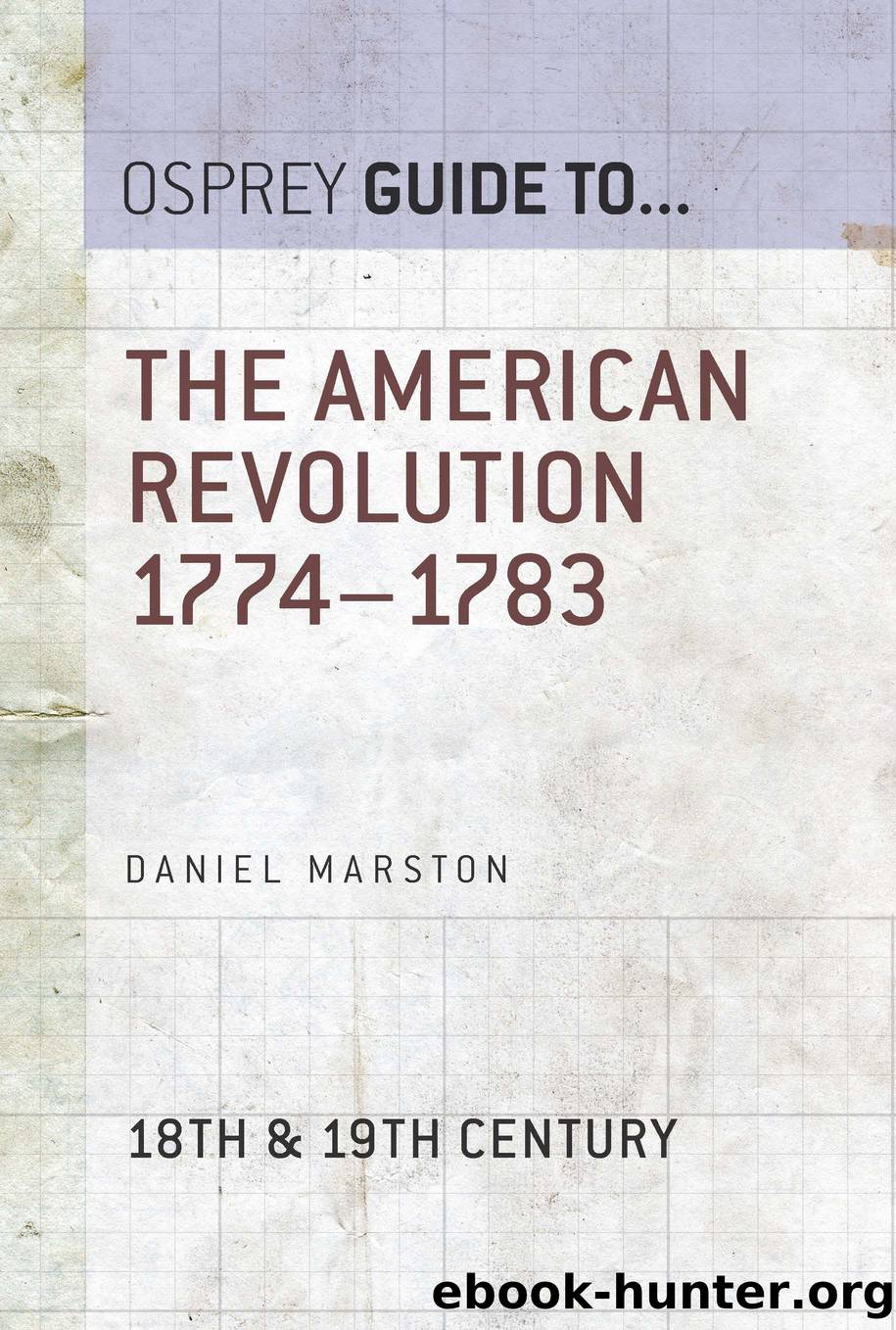The American Revolution 1774–1783 by Daniel Marston

Author:Daniel Marston
Language: eng
Format: epub
Tags: The American Revolution 1774 – 1783
ISBN: 9781472810113
Publisher: Osprey Publishing Ltd
Middle Atlantic campaign
Howe’s campaign in the Middle Atlantic centered around the engagements at Brandywine and Germantown. He moved troops into New Jersey in an attempt to draw Washington and the “Main Army” out for battle. This maneuver produced a series of skirmishes, but was a failure overall, prompting Howe to return to Staten Island. Over the course of July, troops embarked onto Royal Navy ships and transports, and on 23 July the fleet sailed. On 25 August, the fleet landed its cargo on the northern reaches of Chesapeake Bay at the Head of Elk. Washington received word of the landing and marched south with the Main Army, 18,000 strong, to confront the British (Tallmadge, p. 20). Washington placed his army at Brandywine Creek and built up the area into a defensive position.
Though strong generally, the American position had left its flanks unprotected. Howe, approaching with his troops, realized the potential for another successful flank attack. An American soldier described how, “at 8 o’clock in the morning on the 11th [September] a considerable body of the enemy appeared opposite to us” (Shaw Ms. N-49.47).
The battle commenced at 10:00 am. A sizeable column of Hessian and British units were sent in opposite the center and left flank of the American lines, under the command of Lieutenant-General Wilhelm von Knyphausen. A large formation of light infantry, plus Guards and Grenadiers units, under the command of General Cornwallis, moved without being detected against the American right flank, in a march 30 km (18 miles) long, intending to create havoc in the American lines. The other British lines were successful in pushing the American lines back, and the British left flank finally joined the battle at about 4:00 pm. As Major John Andre noted: “the rebels were driven back by the superior fire of the troops, but these troops were too much exhausted to be able to charge or pursue” (Andre, p. 46).
The Americans reacted but did not panic. When the British left flank finally smashed through the American lines, the Americans began to retreat, but in fairly good order, not as a rabble. A French officer serving with the American forces declared: “if the English had followed up their advantages that day, Washington’s Army would have been spoken of no more” (5701-9).
The battle at Brandywine Creek cost the Americans more than 1,000 men killed, wounded, and captured. The British lost half that number. The British had won but were not in a position to follow up their victory aggressively; they were simply too tired after marching 30 km (18 miles). The two armies fell back towards Philadelphia over the next few weeks and a series of small skirmishes took place. On 26 September, the British marched into Philadelphia. This was an important achievement psychologically, but not as important strategically as Howe’s continued failure to completely destroy Washington’s Main Army as it withdrew to the west of the city. The Continental Congress had already been evacuated to Lancaster and later moved to Yorktown. Howe moved to the north of the city and encamped his army at Germantown.
Download
This site does not store any files on its server. We only index and link to content provided by other sites. Please contact the content providers to delete copyright contents if any and email us, we'll remove relevant links or contents immediately.
| Africa | Americas |
| Arctic & Antarctica | Asia |
| Australia & Oceania | Europe |
| Middle East | Russia |
| United States | World |
| Ancient Civilizations | Military |
| Historical Study & Educational Resources |
Washington by Ron Chernow(792)
Patriot Pirates by Robert H. Patton(710)
James Madison: A Life Reconsidered by Lynne Cheney(698)
American Tempest by Harlow Giles Unger(691)
John Adams by David McCullough(649)
The Radicalism of the American Revolution by Gordon S. Wood(635)
Mary Ball Washington by Craig Shirley(608)
George Washington's Secret Six by Brian Kilmeade(607)
The Whites of Their Eyes by Jill Lepore(559)
A Wilderness So Immense by Jon Kukla(534)
American Revolution For Dummies by Steve Wiegand(531)
Henry Knox: Visionary General of the American Revolution by Mark Puls(531)
To Begin the World Over Again by Matthew Lockwood(526)
The American Revolution: A History by Gordon S. Wood(522)
Revolutionary Summer: The Birth of American Independence by Joseph J. Ellis(517)
Poor Richard's Almanack by Benjamin Franklin(511)
The First Conspiracy: The Secret Plot to Kill George Washington by Brad Meltzer & Josh Mensch(511)
The Federalist papers by Alexander Hamilton; James Madison; John Jay; Lawrence Goldman(488)
Paine, Thomas - Complete Works of Thomas Paine by Paine Thomas(472)
